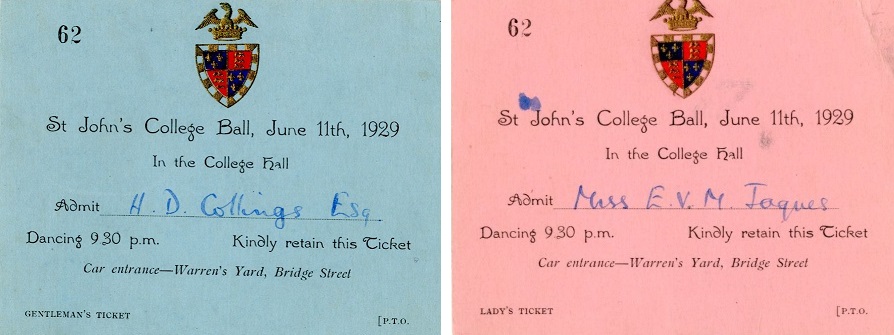May Ball exhibition opens in College Archive Centre
Dinner menus written in French, colour-coded entry tickets for Johnians and their female guests, and dance cards featuring the waltz and the tango are on display alongside many more fascinating items at an exhibition in the College Archive Centre that documents more than 100 years of changing attitudes at the St John’s College May Ball.
Music, Meals and Memories: Delving into St John’s May Ball Collection showcases items from the collection from over 100 years ago to the present day. The exhibition, which is open in the College Archive Centre in the School of Pythagoras from 6 June until 8 July, explores how food, attire and attitudes have changed over the years, and how the May Ball has been shaped by generations of guests.
The Ball has been held at St John’s since at least 1888, and is an opportunity for students who have worked hard during a sometimes stressful academic year to let their hair down before heading off into the world of work. Considered to be one of the best parties in the world, it was first known as the Lady Margaret Ball and was originally a more intimate affair, with dinner held in the Master’s Lodge, and supper in the Combination Room, followed by dancing in the Hall. Since then, the Ball has gradually extended across the whole of the College site, growing considerably in size and scope.
The extensive collection of May Ball material includes tickets, posters, photographs, dance cards, financial accounts, menu cards and programmes, and demonstrates the difference in social attitudes and tradition to that of the present day with regards to forms of entertainment, menus, and general outlook.
In the late 19th century and up until the mid-20th century, for example, menu cards for the Ball were printed in French, due to the popularity of French cuisine. One of the oldest menu cards from the 1898 Ball shows a seven-course supper and includes dishes such as tranche du saumon en mayonnaise and côtelettes d’agneau aux pois Française - with an LMBC cake for dessert. By the 1950s, buffet snacks such as cheese straws and strawberry ices helped to keep guests going through the evening, while snacks in more recent years are more likely to include food such as pizza, hot dogs, crepes, and sushi.
Another tradition which has changed over the decades is the main forms of entertainment such as the shifting popularity of ballroom dancing. Several of the early dance cards on display in the exhibition, such as those from 1898 and 1912, demonstrate that waltzes were once the preferred dance form, yet later dance cards in the 1940s and 1950s reflect an early 20th century expansion in the dance repertoire, which now included the fox-trot, samba, tango and quick-step. By the 1960s, musical performances were starting to feature more as a main form of entertainment, with bands such as The T-Bones (1965), Status Quo (1970) and Hot Chocolate (1996) having all headlined at the Ball, alongside other jazz bands, quartets and a cappella groups.
 Another evident change in attitude and tradition is the use of coloured tickets. Colour-coded tickets, such as those issued for the 1929 Ball, emphasised the difference between Johnians and their female guests: blue for the men and pink for the ladies, though these were later dropped in favour of a more neutral plain white card.
Another evident change in attitude and tradition is the use of coloured tickets. Colour-coded tickets, such as those issued for the 1929 Ball, emphasised the difference between Johnians and their female guests: blue for the men and pink for the ladies, though these were later dropped in favour of a more neutral plain white card.
Guests have always partied the night away at the Ball, enjoying activities such as jousting, shooting ranges, coconut shies, and watching the fireworks, all of which have featured in programmes at one point or another during the Ball’s history. And although it’s difficult to pinpoint exactly when the ‘Survivors’ Photograph’ first came about, programmes on display show that guests enjoyed the Ball until the early hours, having their photos taken at breakfast the next day.
Music, Meals and Memories: Delving into St John’s May Ball Collection is open to members of the College on Wednesdays and Thursdays 10am-4pm from 6 June until 8 July, and to the general public by appointment; contact the Archivist on archivist@joh.cam.ac.uk. The exhibition is also open on Graduation Day, 22 June, for graduands and their families.